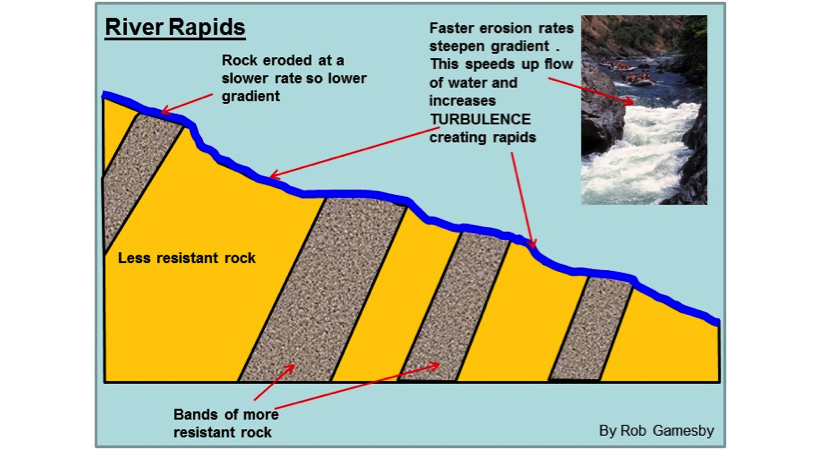Next time you’re rafting, kayaking, or just floating down a river, take a look around. Ever wonder why eddies form in some places but not others? Why some banks have nice, fine sand and others are just full of sharp rocks? UC Davis researcher Lily Tomkovic is here to satisfy your curiosity and explain the fluid mechanics behind the river landscape.
Water movement – and all fluids for that matter – can be characterized in terms of flow regimes. Water can flow in one of two ways: straight and smooth, which hydrologists call laminar, or unpredictably chaotic, or turbulent. For example, if you start two rafts in different places down a laminar flow, you’ll never be able hand a beer to your buddy in the other raft since your paths will be parallel. This is why most rafting trips don’t go down laminar rivers. With turbulent flow, on the other hand, there’s a good chance you’ll be playing bumper rafts, get stuck in an eddy, and experience some sweet rapids.

But what determines whether the flow is laminar or turbulent? In 1851 George Stokes figured out that turbulence could be defined in terms of the inertia (fluid density, velocity, and length traveled) and viscosity of the fluid. He developed the following formula:
Reynolds number = Re = inertial forces / viscous forces
(Unfortunately for Stokes, no one paid much attention to his equation until Osborne Reynolds popularized it in 1883, for whom it got its name.) The higher is Reynold’s number, the more turbulent the water.
So why do we see rapids in certain places but not others? Almost 200 years ago, a brilliant British scientist, William Froude, defined a way to measure the force of water relative to its surroundings. Looking at the Froude number before and after a rapid can tell us how frothy and exciting the rapid will be.

A critical flow occurs when the inertial forces are exactly equal to gravitational force (Fr = 1). Subcritical flows (Fr < 1) characterize calm, deep water, where surface waves can propagate upstream. At the other extreme, you’d find supercritical flows (Fr >1) in shallower, faster water, where surface waves can’t propagate upstream. You’ll experience a rapid, or hydraulic leap in hydrologist lingo, when the flow goes from supercritical to subcritical. The release of kinetic energy as the fast-moving super critical water comes into contact with the slower-moving subcritical water causes some of the cohesive forces that usually hold the water together to be forced apart, causing froth and foam.
So what dictates whether the flow is laminar or turbulent, subcritical or supercritical? This is where geology comes in. The form and depth of the river and the density of the rocks in the riverbed influence how water moves through the river channel. In places where the rocks are super dense, the water can’t erode the rocks as quickly as in places with lower-density rocks. When rock densities alternate along a riverbed, the water will speed up in places with less resistant rocks and slow down over the more resistant rocks, generating periodic turbulence in the flow.

The shape of the river also influences the flow regime at different points along the river. When a river goes around a bend, the centrifugal force pushes the water toward the outer edge of the bend, which raises the water level. (It’s the same force that’s operating when you’re playing jello in the car and your entire body gets thrown violently against the door on the right when you go around a sharp turn to the left.) Thanks to gravity, the pressure difference from the higher water level pushes the flow of water down toward the bottom of the riverbed and then downstream where it bounces back up again, generating a swirly, helical flow.
BUT, the story gets more complex because the flow of water can also influence the form of the river. Over time, the centrifugal force of the water pushes the outer bank farther and farther out at each bend. As the curves get stretched out, the river slowly meanders itself into a lake to save energy from repeatedly bouncing off the river walls. Hydrologists call this type of movement an oxbow lake formation.

Lastly, as water flows through the river channel, it picks up sediment in a process called entrainment. Just like water is pushed to the outer edges of a curve in the river, the centrifugal force of the flow causes larger sediment particles to be deposited in shallower parts of the river, where the current is slower. Finer particles, on the other hand, get pulled along the river. Between ox bow tendencies and sediment entrainment, the shape of the river is constantly changing right before your eyes, though at glacial speeds.
